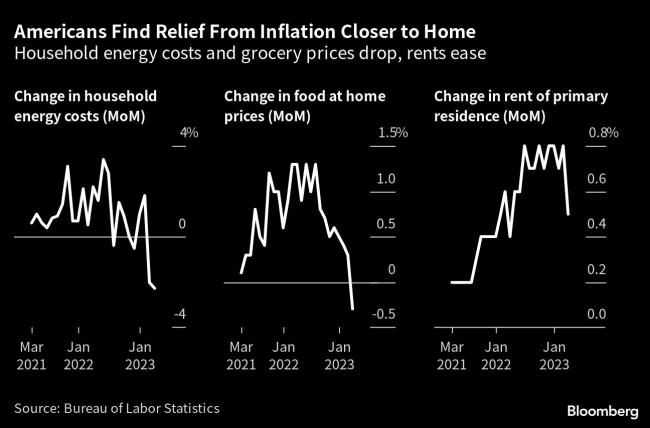(Bloomberg) -- The costs of many US household necessities retreated in March from a month earlier in welcome news for families that have been strapped by an extended period of rapid inflation.
Key measures of housing costs registered their smallest monthly advances in about a year, while prices of groceries dropped for the first time since 2020 and household energy slid by the most in almost nine years, according to government data out Wednesday.
That, along with a drop in gasoline prices, contributed to a smaller-than-expected 0.1% monthly increase in the consumer price index.
“A reprieve in price growth for frequently purchased necessities — energy and food — held the headline CPI to a more palatable gain and provided consumers a little more wiggle-room in their March budgets,” Wells Fargo (NYSE:WFC) & Co. economists Sarah House and Michael Pugliese said in a note.
“Yet, while there is likely some further scope for energy services and food inflation to ease on a monthly basis in the near-term, the benefit to real incomes from lower gasoline prices is unlikely to carry over to April, as prices at the pump have rebounded in recent weeks,” they wrote.
Retail gasoline prices have rebounded to the highest since November in the wake of the announcement by OPEC+ to cut production.
The Labor Department’s CPI report showed a 0.5% gain in rent of primary residence, the smallest advance in a year. A gauge of what homeowners would charge renters also cooled. Housing accounts for about a third of the CPI.
Economists largely expect shelter prices to come down later this year. Because of the way housing metrics are calculated, there’s a significant lag between real-time price changes and the government statistics.
Electricity prices decreased by the most in more than two years and piped gas service costs were down more than 7%.
The cost of food at home, meanwhile, dropped 0.3% and reflected slides in the prices of eggs, meats, chicken and fish. Milk prices fell by the most in more than two years, while fresh fruits and vegetables decreased 1.7% in the largest monthly retreat since 2017.
While the drop in costs of necessities is welcome news, so-called core inflation that excludes food and energy remains stubborn. With the core rate rising 0.4% from the prior month and 5.6% from March 2022, the path remains open to another increase in interest rates by the Federal Reserve early next month.
